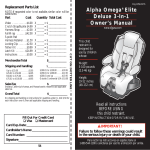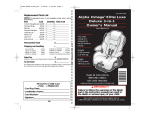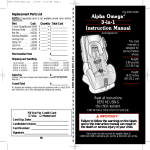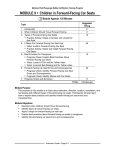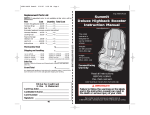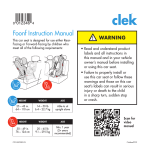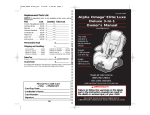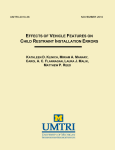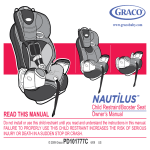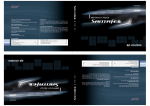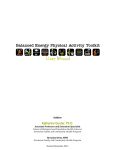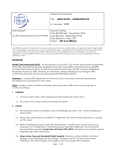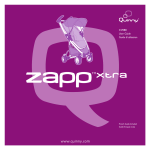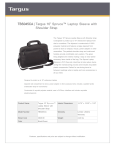Download Children in Forward-Facing Car Seats
Transcript
MODULE 9 National Child Passenger Safety Certification Training Program Children in Forward-Facing Car Seats OBJECTIVES • Describe when children should travel forward-facing. • Identify types of forward-facing car seats. • Apply 5 steps for forward-facing car seat use. • Explain best practices about forward-facing car seats to caregivers. • Identify forward-facing car seat errors and consequences. WHEN CHILDREN SHOULD TRAVEL FORWARD-FACING Children should: • Remain in a rear-facing car seat until reaching the top height or weight limit allowed by the car seat manufacturer. • Ride in a forward-facing car seat with a harness until they reach the top height or weight limit allowed by the car seat manufacturer – usually until they are between ages 4 to 7. • It is dangerous to exceed height or weight limits. There are five types of forward-facing car seats: convertible, combination, forward-facing-only, large medical seats or vests, and integrated seats. NOTE: There are always car seats that do not fit into these categories. For example, there are car seats that rear-face, forward-face, and then become booster seats. FORWARD-FACING CONVERTIBLE CAR SEAT • Manufacturer instructions for many car seats recommend they be in the upright position when used forward-facing. • Some manufacturers meet testing standards with their seat in a forward-facing, semireclined position, as well as fully upright. Consider this position if the child has special needs or if seat belts cannot be made tight when the car seat is upright. • Some harness systems are approved for use to 40 pounds, but the marketplace is changing and now includes more seats with higher weight limit harnesses. • A 5-point harness provides more protection for a child than a booster seat with a lap-andshoulder seat belt. • Read the owner's manual to ensure correct use of the belt path and harness slots. Page 9-1 Forward-facing convertible car seat FORWARD-FACING COMBINATION CAR SEAT The forward-facing combination car seat is used with a harness until a certain height or weight limit specified by the manufacturer is reached. The harness must then be removed or stored. • Make sure the mid-point of the back of head or top of ears are NOT above the top of the shell or as directed by the car seat manufacturer. • The backs of all combination seats are reinforced. Any harness slot can be used as long as it is at or above the child’s shoulders. • This car seat does not have air bag warning labels because combination car seats are forward-facing-only and most have a lower weight limit of 20 pounds. • Once the harness is removed, this seat can then be used as a belt-positioning booster seat. Forward-facing combination car seat FORWARD-FACING-ONLY CAR SEATS Forward-facing-only car seats are sometimes used for children with special health needs or for heavier children who are not behaviorally mature enough for a booster seat. • • With forward-facing-only car seats, the weight limits can vary. Some have higher harness weight limits than other forward-facing car seats. Forward-facing-only car seat It is important to research and remain aware of currently available car seats with higher weight harnesses. LARGE MEDICAL SEATS AND VESTS Large medical seats, vests, and harnesses may help children with behavioral issues, weak muscles, excess weight, or other situations when a conventional car seat cannot be used. • Large medical seats are designed for occupants who require supplemental positioning support from a car seat beyond that offered by a conventional restraint. Typically, large medical seats will fit occupants weighing up to 102 to 135 pounds (a few go higher). • There are different vests available in different sizes for use as restraints. In order to use a vest, a child must have good head control. Some products are made just for school bus use. • It is important for families to work with an occupational therapist (OT) or physical therapist (PT) to evaluate a child’s positioning needs and determine which restraint provides the best positioning options for the child. • • Heavy-duty tethers are sometimes required. Always follow the manufacturer instructions. Page 9-2 Large medical seat Vest INTEGRATED SEATS Some vehicles have seats/restraints built into the vehicle. Check the vehicle owner’s manual for instructions and weight limits. • Many integrated seats face forward. Some can be used as a booster seat. They CANNOT be moved. • • Some have a 5-point harness. • Caregivers should call the service department of the vehicle dealership and ask to be given information in the repair section of the service manual about replacing car seat parts. Integrated seats, as with other car seats, may need to be replaced after a vehicle collision, if webbing is frayed, or parts are missing or broken. Check the vehicle owner’s manual for instructions. Integrated seat HARNESS FIT Tighten harness straps snugly. A snug harness lies flat and passes the pinch test. Bulky clothing can interfere with proper harness fit. • Avoid bulky clothing or padding behind the child’s head, back, or under buttocks. • Bulky jackets can be put on backwards (over child’s arms and torso) after the harness is secured. • Place blankets over and around the child after the harness is snug. Children should sit with: ! ! Their back and bottom flat against the car seat back. ! The harness straps placed over the shoulders and buckled at the crotch. ! The retainer clip at armpit level. The harness placed through proper slots, usually at or above the child’s shoulders. Refer to the car seat manufacturer instructions. Page 9-3 TIPS FOR DISCUSSING HARNESS FIT • Some car seats have unusual belt paths or routing instructions. • Harness slot reinforcement and structures that look like reinforcement may not be visible. • The only way to know for certain is to read the manufacturer instructions. MODULE 9 • Children in Forward-Facing Car Seats • Practice Activity: Adjust a Harness and Locate the Belt Path In small groups, adjust a harness for height and weight limits. A child (doll and card with age, weight, and height) will be assigned to your group. 1. Working with a forward-facing car seat and doll, move the harness to a different harness slot. Adjust the harness to loosen and tighten. 2. Adjust the car seat harness so it fits the doll. 3. Identify the location of the harness adjustments. 4. Identify the forward-facing seat belt path, lower anchor attachment belt path, and tether strap on the car seat. 5. Adjust the car seat to either the upright or forward-facing recline position (if allowed by the manufacturer. 6. Answer the following questions. Questions 1. Is the harness adjustment in the front or on the back of the car seat? 2. Is it easy to read labels and instruction manual, locate and identify harness adjustment lock-offs, etc.? 3. Where are the lower anchors and tether stored when not in use? 5 STEPS FOR FORWARD-FACING CAR SEAT USE The following is an application of 5 steps to forward-facing car seat use. 1. Selection: Choose the Right Car Seat As with all car seats, select the one that is right for the child’s height, weight, developmental levels, AND that a caregiver can use correctly. 2. Direction: Face the Car Seat the Right Way A child should be kept in a forward-facing car seat with a harness until reaching the top height or weight limit allowed by the car seat manufacturer. This is generally between the ages of 4 to 7. 3. Location: Install the Car Seat in an Appropriate Location in the Vehicle • As with rear-facing car seats, while there may be many seating positions in a vehicle, not all may be suitable for installing a car seat. • As long as the car seat fits, the rear center seating position may be safer because it is furthest from impact and intrusion from any direction. However, some rear center positions are not usable and many families transport more than one child. • Weight limits on lower anchors and tether anchors can affect the seating position choice. Each vehicle manufacturer sets these weight limits. Check the vehicle owner’s manual or most current LATCH Manual (if available) for individual vehicle limits. Page 9-4 4. Installation: Secure the Car Seat to the Vehicle in the Right Way • • A tether increases safety by limiting forward movement and rotation of the car seat. Using the tether strap can stabilize a car seat and limit head movement. • NEVER place noodles or towels behind or under a forward-facing car seat unless allowed by the manufacturer. General methods to obtain a tight installation include: 1. Place the car seat on the selected vehicle seat in the proper direction, ensuring that the angle adjustment is in the correct position for the child. 2. Place the seat belt or lower anchor webbing through the car seat belt path as directed by the manufacturer. 3. Buckle and lock the seat belt or secure lower anchors. 4. Place your hand in the car seat and use leverage to compress the car seat into the vehicle seat cushion while tightening the seat belt or lower anchors. 5. Tighten to ensure the seat does not move more than 1 inch when testing at the belt path. 6. Identify the vehicle tether anchor. Attach and tighten the tether strap. 7. Test again for a tight installation. Page 9-5 TIPS FOR DISCUSSING FORWARD-FACING CAR SEATS • Always discuss the transportation needs of the family. • Unused seat belts may be within reach of a child when a car seat is installed with lower connectors. Technicians should educate the caregiver to evaluate the risk of entanglement from unused seat belts. Secure unused seat belts as directed by the vehicle manufacturer. • Encourage caregivers to use the tether with a forward-facing car seat whenever possible, whether installing with the seat belt or lower anchors. • Show caregivers how to place lower anchors through a forwardfacing belt path. • Explain the importance of storing the LATCH attachments. MODULE 9 • Children in Forward-Facing Car Seats Consider seating positions with seat belts that can be locked (locking latchplate, switchable, or automatic locking retractors) or approved lower anchor positions for car seat use. VIDEO • Install a Forward-Facing Car Seat Record steps you observe to install a forward-facing car seat with a harness using a seat belt. 1. 2. 3. 4. HOW TO TEST THE INSTALLATION • To test the installation, grip the car seat at or near the belt path and pull on the car seat. • There should be no more than 1 inch of side-toside or forward movement at the belt path. • Tighten the harness straps snugly. You should NOT be able to pinch excess webbing at the shoulders once the harness is buckled and tightened. 5. 6. 7. 8. What do you need to take into account when using the lower anchors to secure the car seat? Page 9-6 Common Forward-Facing Installation Errors Caregivers make the following common forward-facing installation errors: A seat belt or lower anchor attachment that is too loose or not locked • Incorrect use of lower anchors and tether, not installing lower anchor attachments to the correct designated lower anchor bars or attaching the connectors upside down • • • Not using the appropriate tether anchor or using it when it should not be used • Installing a seat with LATCH when the child weighs more than the vehicle and/or car seat LATCH weight limits A rear-facing-only car seat that is forward-facing Seat belt or lower anchor attachments routed incorrectly through the wrong belt path Recline angle not adjusted appropriately for forward-facing direction Using two seat belts, or using a seat belt and lower anchor attachments together (unless allowed by the car seat and the vehicle manufacturers) Locking clip installed incorrectly Installing a car seat with lower anchors in a seating position that is not a designated LATCH position 5. Harnessing: Place the Child Correctly in the Car Seat There are four steps for correctly harnessing a child in a car seat. 1. Place the child all the way back in the car seat. 2. Put the harness straps over the shoulders and buckle at the crotch. The harness holds the child back against the car seat so he or she does not slide out in a crash. The crotch strap keeps the child from moving forward. 3. Tighten the harness straps snugly. You should NOT be able to pinch excess webbing at the shoulders once the harness is buckled. 4. Secure and place the harness retainer clip at armpit level. Common Forward-Facing Harnessing Errors Caregivers make the following common forward-facing harnessing errors: • • • • Harness not used (child just sitting in the car seat) • • • • • Harness is twisted or incorrectly routed Harness straps are too loose Retainer clip not at armpit level Harness routed through the wrong slots. (NOTE: Harness may look as though it is properly routed through the pad, but it may not be routed correctly through the shell.) Harness not placed on the child correctly Harness is frayed or damaged Metal adjuster not flush with a slot or out of position Crotch strap is adjusted too long, or not through slot closest to the child Page 9-7 MODULE 9 • Children in Forward-Facing Car Seats • • • • • Practice Activity: Select and Install Forward-Facing Car Seats Select and install car seats by a child’s age, height, and weight. A child (card with age, weight, height) will be assigned. 1. Your group becomes the caregivers of a child with a specific age, height, and weight. 2. Select the correct car seat for the child, adjust the harness straps and angle, and determine the belt path. 3. Work together to install your car seat. 4. Document retractor and latchplate types and how your vehicle seat belt locks. 5. If you identify any errors, document them in the second and third charts. Seat to Install How Does the Vehicle Seat Belt Lock? Forwardfacing convertible Retractor: Instructor Initials Latchplate: How does it lock? Combination seat with harness Retractor: Latchplate: How does it lock? Your choice Retractor: Latchplate: How does it lock? Car Seat Harnessing Harness slots used are best for child’s age and size Parts present and in good condition Straps around frame/shell and through slots correctly Straps and harness fit correctly Retainer clip positioned correctly Harness snug enough Y Y Y Y Y Y N N N N N N NA NA NA NA NA NA Y Y Y Y Y Y Y Y Y N N N N N N N N N NA NA NA NA NA NA NA NA NA Car Seat Installation Installed in seating position with active front or side air bag Best seating position being used Correct forward or rear-facing position Correct recline angle used Seat belt routed correctly Seat belt locked Lower attachments used correctly Tether installed and used correctly Installation tight enough Page 9-8 Explain Best Practices About Forward-Facing Car Seats Key Questions ! ! What are the age, weight, and height of the child? ! ! ! ! ! ! What type of forward-facing car seat is this? What does the car seat owner’s manual (or label) say about the minimum and maximum weights and heights for the child using this car seat? Is the car seat facing the right way in the vehicle? Considering everyone who rides in this vehicle, is the car seat in the best seating position? Is the car seat secured by a seat belt or with lower anchor attachments? Is the car seat installed tightly? Is the tether used if present/able? Best Practices Answer the following questions to prepare for conversations you will have with caregivers to educate them about forward-facing car seats. 1. My child is two years old and weighs 39 pounds. Which car seat should I buy? 2. May I use this car seat with a side air bag in a back seat? 3. My child fits in the harness, but weighs 43 pounds. Can I keep using this car seat? 4. Should I use LATCH or the seat belt? 5. Do I have to use the tether? 6. My child climbs out of the car seat. What should I do? Page 9-9 MODULE 9 • Children in Forward-Facing Car Seats There are key questions to answer related to forward-facing car seats. Explain and demonstrate best practices to caregivers. Progress Check: Identify Forward-Facing Car Seat Errors and Consequences 1. Examine each photograph to determine if the forward-facing car seat is fitted properly. 2. If not fitted properly, identify the errors and consequences to the child. 1. Error: Consequences: 2. Error: Consequences: 3. Error: Consequences: Page 9-10 Progress Check: Identify Forward-Facing Car Seat Errors and Consequences (continued) 4. Error: 5. Error: Consequences: Page 9-11 MODULE 9 • Children in Forward-Facing Car Seats Consequences: Practice Activity: Identify Misuse with Car Seats Identify misuse with several car seats. 1. In small groups, carefully examine the information about the child’s age, height, and weight. Also, check car seat labels that have been set up in the classroom. 2. Take notes on what you discover regarding car seat misuse for each scenario. 3. Use the sample checklists provided below to record your answers for at least one of the scenarios. 1. 2. 3. 4. 5. 6. 7. Car Seat Selection Car Seat Used " Rear-facing-only " Harness vest Car seat type best for age/size? Car seat manufacturer: Model #: " Convertible " Forward-facing with harness " High-back booster " Backless booster Y N NA Car seat model name: Mfg date: Under recall? Y N NA Car Seat Use Type of harness best for age and size? Parts present and good condition? Straps around frame/shell and through slots correctly? Straps and harness fit correctly? Retainer clip positioned correctly? Harness adjustment mechanism locked? Harness snug enough? Correct front-facing position? Correct recline angle used? Page 9-12 Y Y Y Y Y Y Y Y Y N N N N N N N N N NA NA NA NA NA NA NA NA NA Progress Check and Summary 1. How do you determine which harness slots to use for a forward-facing child? 3. How do you find the correct belt path? 4. How tightly should a forward-facing car seat be installed? 5. What is the benefit of using a tether? Page 9-13 MODULE 9 • Children in Forward-Facing Car Seats 2. What is the correct way to secure a child in a forward-facing car seat? Page 9-14














